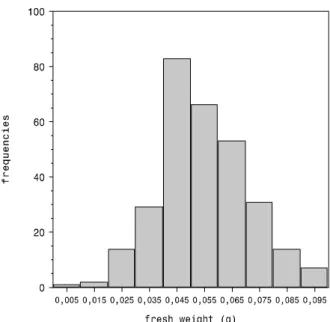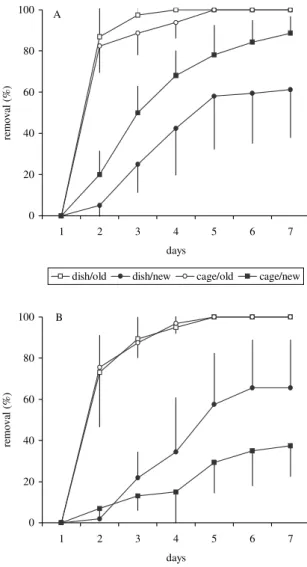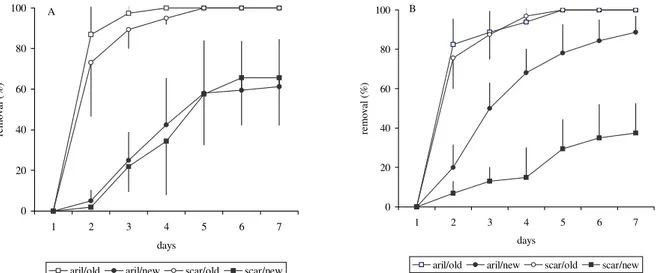1 Recebido para publicação em 11.11.2002 e aceito para publicação em 08.6.2004
2 Departamento de Botânica da Universidade Estadual Paulista (UNESP), 13506-900 Rio Claro, SP, Brasil. <victorjc@rc.unesp.br> 3 Departamento de Ecologia da Universidade Estadual Paulista (UNESP), Rio Claro, <mgaletti@rc.unesp.br>
1. INTRODUCTION
Michelia champaca (Magnoliaceae) is known world
wide for its large, very aromatic yellow blossoms and the striking appearance of the tree with its smooth trunk and large ovate, glossy leaves. The species is a tropical evergreen native to India and Indonesia, extending into the Indonesia and Taiwan. It is
large-Giovano Candiani2 , Mauro Galetti3 e Victor Jose Mendes Cardoso2
ABSTRACT - We tested the influence of the aril on seed germination in controlled conditions and on the removal of M. champaca seeds in natural environment. Germination assays were kept at 25 ± 2 °C under
continuous white light. Removal experiments were carried out in three “old” (39 to 62-years old) and three “new” (15-years old) eucalyptstands in Horto Florestal Navarro de Andrade, Rio Claro, SP. The results show that the aril inhibits the germination and the seeds exhibit a positively photoblastic reaction. We found higher seed removal in old eucalypt stands than the new ones, probably due to the higher density of rodents in the old stands. In the new stands, we found higher seed removal of arillated seeds by ants. Ants are important to remove the aril of seeds dropped by birds, not only enhancing seed germination but also preventing seed predation by rodents.
Key words: Champak tree, ecology, eucalypt stands, dormancy and aril.
GERMINAÇÃO E REMOÇÃO DE SEMENTES DE Michelia champaca
L.
(MAGNOLIACEAE) EM TALHÕES DE EUCALIPTO: INFLUÊNCIA DO ARILO
RESUMO - Testou-se o efeito do arilo na germinação de M. champaca em condições controladas, bem como na sua remoção, em ambiente natural. Os ensaios de germinação foram mantidos a 25 ± 2 °C, sob luz branca constante. Os experimentos de remoção foram levados a cabo em três talhões “velhos (idades de 39 a 62 anos) e três “novos” (15 anos de idade) de eucaliptomantidos no Horto Florestal Navarro de Andrade, em Rio Claro, SP. Os resultados indicaram que o arilo inibe a germinação, sendo as sementes fotoblásticas positivas. Observou-se que a remoção de sementes foi maior em talhões “velhos” do que em “novos”, provavelmente devido à maior densidade de roedores nos talhões velhos. Nos talhões novos, verificou-se que formigas removiam mais sementes ariladas. Esses insetos são importantes agentes na remoção do arilo de sementes derrubadas por pássaros, promovendo, assim, aumento na germinação e evitando a possível predação das sementes por roedores.
Palavras-chave: Magnólia-amarela, ecologia, talhões de eucalipto, dormência e arilo.
ly found in plains, uplands and also in forests. In Brazil it is planted along roadsides for its flowers and shadow. It flowers and fruits in November to May, and the carpidium fruits with dorsal suture are ovoid, coni-cal, dark brown with compressed seeds. After dehis-cence it exposes red-oily arillated seeds that remain attached to the fruit. Seed covering structures such as aril and elaiosomes can act as attraction for
ani-SEED GERMINATION AND REMOVAL OF
Michelia champaca
L.
mal dispersors, since they are coloured and rich in energetic compounds, mainly lipids (GUIMARÃES JR. and COGNI, 2000). Otherwise, aril can reduces the seed viability by allowing infection by fungus, which reduces the germination capacity (PIZO, 1994).
The seed coat is known to impose and maintain dormancy in a number of species. The mechanisms by which the coat acts involve a number of possibi-lities and include the presence of chemical inhibitors in the covering structures (BEWLEY and BLACK, 1994). Norman (1971) reported that the germination rate of
M. champaca seeds is affected by the aril probably
due to the presence of inhibitors as well as by inter-ference with water uptake.
Coat imposed dormancy is generally overcome in laboratory conditions by various physical or che-mical operations such as washing in water or orga-nic solvents, perforation and scarification. In the natural environment it is known that passage through digestive tract, as well as the simple removal of covering structures without ingestion by animals can improve the seed germination.
The reproductive success of the plant also de-pends on its capacity for dispersing its seeds or diaspores. This seed movement away from the parent may involve a complex relationship between plant and seed dis-perser, which influences the germination and seedling establishment (FORGET and MILLERON, 1991). Stu-dies on seed dispersal coupled to germination are important tools for conservation projects and fores-try as well as for understanding the structures of the plant communities and their regeneration processes (HOWE, 1984). Considering that the seed removal is the first step for a successful dispersal and conside-ring that the aril can play an important role both on seed germination and dispersal, we tested the influ-ence of the aril on the seed germination of kapok tree in controlled conditions and on the seed removal in different eucalypt stands. We tested the hypothesis
that seed removal can be affected by both the age of the stands and the seed coat.
2. MATERIAL AND METHODS
M. champaca (Magnoliaceae) seeds were collected
from plants growing in Rio Claro (SP), Brazil. The seeds were stored in paper bags for up to three months at room temperature (26 ± 4 °C).
The seeds were characterised for water content, fresh weight and viability. Five samples of 50 seeds were drawn from the batch and the aril removed with the aid of filter paper sheets. The samples were weighted (FW) and heated at 105 °C for 48h in a dry oven (DW), and the water content (WC) determined as follow: WC (%) = [(FW-DW)/FW].100. For distribution of seed fresh weights 300 arillated seeds were picked at ran-dom and were individually weighed in an analytical balance, with the data being grouped into ten clas-ses. The frequency polygons were traced through the class marks and curtosis was evaluated by compu-tation of G2 statistics (SOKAL and ROHLF, 1995).
The viability was assessed in samples of 80 seeds that were cut longitudinally and imbibed into a 0.5% aqueous solution of 2,3,5-tryphenyl-tetrazolium chloride for 24h at 35 °C in the dark.
2.1. Germination experiments 2.1.1. Michelia champaca
The germination assays were performed in 12 x 12 cm plastic germination boxes with intact and sca-rified seeds sowed on sterilised sand moistened with distilled water and kept at 25 ± 2 °C under continuous white light provided by four fluorescent tubes of 15W each. For treatments excluding light, black germina-tion boxes were used. Five boxes per treatment were used, with 20 seeds per box. Scarification was per-formed by pressing the seeds between two filter paper sheets to remove the aril. Germination criteria was the radicle protrusion.
2.1.2. Lactuca sativa L.
germination rate (1/t) were analysed, with t (average germination time) = Σni.ti/Σni; ni is the number of germinated seeds at time interval ti (LABOURIAU, 1983).
The germination rate was compared through non para-metric Mann-Whitney test (SOKAL and ROHLF, 1995).
2.2. Seed removal in the wilds
Removal experiments were carried out in four “old” (39 to 62-years old at the time of the assays) and four “new” (15-years old) eucalyptstands in Horto Flo-restal Navarro de Andrade, Rio Claro, SP (22o 25’S,
47o 34’W). The “old” stands were: number 42, a E. umbra
planting from 1960; number 43, E. tereticornis Sm.,
1911; number 44, E. citriodora Hook, 1935 and; number
49, E. saligna Sm., 1937. The “new” stands were: number
29, E. tereticornis Sm., 1984; number 33, E. urophylla
S.T. Blake, 1984; number 34, E. urophylla S.T. Blake,
1984 and; number 36, Corymbia citriodora (Hook.)
K.D. Hill & L.A.S. Jhonson, 1984 (GOMES de SÁ, 1987). A randomised block design was conducted in a 2x2x2 factorial arrange. In each eucalypt age group we set up four replicates, with one replicate per stand. In each replicate, 20 intact or arillated seeds were placed in plastic dishes (20 seeds per dish) distributed every 5 meters along a 20m transect. In order to evaluate the seed removal by each vector, metallic cages (PIZO and OLIVEIRA, 1998) were used in treatments avoi-ding the free access of rodents and birds to the seeds in the petri dishes placed on the ground (T1). In treatments preventing the access of ants (T2) the dishes were maintained about 5 cm over ground using a long greased nail. T1 and T2 treatments with arillated and scarifi-ed sescarifi-eds were put alternately (T1 arillatscarifi-ed – T2 ari-llated – T1 scarified – T2 scarified) along transect. Seeds were checked daily to see if they had been removed, considering removal when the seed was out of the dish or cage. The mean percentages of removed seeds were determined.
3. RESULTS AND DISCUSSION
The assessment of seed lot homogeneity was carried out through the distribution of individual seed fresh weight, which exhibits a leptocurtic pattern with mode lying in the 0.04-0.05g interval (Figure 1). The mean seed water content was 9,2% (fresh weight basis) and nearly 91% of the seeds were viable (tetrazolium test).
M. champaca seeds present in general high viability
(BAHUGUNA and RAWAT, 1988).
The results show that the aril inhibits the ger-minability whereas the germination rate is not influ-enced statistically (Table 1); thus, aril affects germi-nation in M. champaca by limiting the germination
capacity. It was also observed that germination is fully inhibited in darkness both in intact and scarified seeds (Table 1) showing that M. champaca seeds exhibit a
positive photoblastic reaction. The relatively low germinability (74%) of the scarified seeds as compa-red to the high viability (91%) assessed by the tetra-zolium test suggests the occurrence of a dormancy not caused by the aril. The germination of scarified seeds was completed after 75 days and peaked around 25 days whereas intact seeds germinated poorly after 39 days. The mean time to germination was around 38 for intact seeds and 36 days for scarified ones at 25 °C, such pattern resembles that obtained by Norman (1971) with M. champaca seeds. In order to evaluate
the aril for inhibitors, aqueous extract were tested with lettuce seeds and the results show that aril extract inhibits the germination of lettuce seeds (Table 2). The kind of inhibitor was not determined in this work but Wan et al. (1990) reported several alkaloids in M. champaca, suggesting that alkaloids may account for
the inhibition. Pizo (1994) observed that aril inhibits
Figure 1 – Frequency distribution of individual seed fresh weight of M. champaca.
the germination of Cabralea canjerana (Vell.) Mart.
probably due to fungi infestation in arillated seeds that reduces both the seed viability and germinabi-lity.
We found higher seed removal in old eucalypt
stands than the new ones irrespective of the exclu-sion treatments and seed scarification. Thus the stand effect predominated in both intact and scarified se-eds as well as in dishes and cages (Figures 2 and 3). No differences were observed between treatments ex-cluding vertebrates and ants, in both intact and scarified seeds (Figure 2). Considering only exclusion treat-ments, no difference was observed between intact and scarified seeds put in dishes either in old or new stands (Figure 3) whereas a lower removal in scarified than in arillated seeds occurred in treatments excluding
verte-Table 1 – “In vitro” germination of intact (arillated) and scarified seeds of M. champaca in darkness (D)
and white light (L), at 25 °C. Small letters compare germination rate (Mann-Whitney test) and germinability (F test) of intact and scarified seeds. Quadro 1 – Germinação “in vitro” de sementes intactas (ariladas) e escarificadas de M. champaca germinadas em escuro (D) e luz branca (L) a 25 °C. Letras pequenas comparam a velocidade de germinação (teste de Mann-Whitney) e germinabilidade (teste F) de sementes intactas e escarificadas.
Average Germination Germinability Germination Rate . (%)
Time (Days)
Intact L 38.2 0.026a 4.2b
D 0 0 0
Scarified L 35.8 0.029a 74a
D 0 0 0
Table 2 – Germinability of lettuce seed in distilled water and aril extract from M. champaca seeds. Small letters
compare germinability in distilled water and extract Quadro 2 – Germinabilidade de sementes de alface em água destilada e em extrato de arilo de sementes de M. champaca letras pequenas (teste F) comparam a germinabilidade em água destilada e extrato
0 20 40 60 80 100
1 2 3 4 5 6 7
days
remov
al
(%
)
dish/old dish/new cage/old cage/new A
0 20 40 60 80 100
1 2 3 4 5 6 7
days
remova
l (%
)
dish/old dish/new cage/old cage/new B
Figure 2 – Removal (mean ± s.e.) of arillated (A) and scarified (B) M. champaca seeds in treatments excluding
the free access of small vertebrates (cage) and ants (dish), in both old and new eucaliptsspp stands. Figura 2 – Remoção (média ± erro padrão) de sementes ariladas (A) e escarificadas (B) de M. champaca em tratamentos de exclusão de pequenos vertebrados (gaiola) e formigas (placa), em talhões novos e velhos de eucalipto.
Germinability (%) Distilled Water 94.0a
Extract 1.3b
may account for the higher seed removal in the old eucalypt sites. Stallings (1991), studied the effect of the understorey on the mammals diversity in eucalypt stands and reported the occurrence of one rodent species when understorey was absent, whereas five marsu-pial, three rodents and four carnivores species were observed in stands with understorey.
The aril did not affect seed removal in treatments excluding ants but did it when vertebrates were ex-cluded in new stands in which removal of arillated seeds was higher than intact ones (Figure 3), suggesting that differences may occur between new and old stands as to ant population size and/or species. A site effect on seed removal was also observed by Guimarães Jr. and Cogni (2000), who placed arillated and cleaned seeds of Cupania vernalis Camb ess. both on the edge
and inside the forest. They reported a higher remo-val of arillated seeds inside the forest whereas no di-fference was observed among intact and cleaned seeds placed on the edge of the forest. Beattie and Culver (STILES, 1992) reported that ants vary greatly in their response to different elaiosomes, and that variation is among species, populations and even within a population. According to Horvitz (1981) arils are similar to elaiosomes attracting ants since both are rich in lipids. Considering that seeds of champak are eaten by birds (LOMBARDI and MOTTA, 1994), we postulate
0 20 40 60 80 100
1 2 3 4 5 6 7
days
re
m
ov
al
(%
)
aril/old aril/new scar/old scar/new A
0 20 40 60 80 100
1 2 3 4 5 6 7
days
re
m
ova
l (
%
)
aril/old aril/new scar/old scar/new B
Figure 3 – Removal (mean ± s.e.) of arillated and scarified M. champaca seeds in old and new Eucalypt stands, in dishes (A) and cages (B).
Figura 3 – Remoção (média ± erro padrão) de sementes ariladas e intactas de M. champaca em talhões novos e velhos de eucalipto, em placas (A) e gaiolas (B).
that ants are important to remove the aril of M cham-paca seeds dropped by birds not only enhancing seed
germination but also preventing seed predation by rodents.
In conclusion, the germination of Michelia cham-paca L. seeds is hindered probably due to the
pre-sence of inhibiting substances in the aril, and buried seeds tend to keep dormant since they are light re-quiring ones. The higher density of both rodents and ants may account for the higher removal in the “old” than in the “new” eucalypt stands; the removal of the aril by ants may enhance the seed germination of M. champaca.
4. REFERENCES
BEWLEY, J.D.; BLACK, M. Seeds physiology of development and germination. New York: Plenum Press, 1994. 445p.
BAHUGUNA, V.K.; RAWAT, M.M.S. Studies on dormancy and treatment to enhance germination of champak (Michelia champaca, L.) seed. Indian Forester, v. 114, p. 317-319, 1988.
FORGET, P.M.; MILLERON, T. Evidence for secondary seed dispersal by rodents in Panama.
GOMES DE SÁ, J.A.C. Quadro geral das plantações florestais. Rio Claro: FEPASA, 1987. 17p.
GUIMARÃES JR., P.; COGNI, R. Seed cleaning of
Cupania vernalis by ants: edge effect in a
highland forest in southeast Brazil. In:
INTERNATION SYMPOSIUM-WORKSHOP ON FRUGIVORES AND SEED DISPERSAL, 3., 2000. São Pedro. Abstracts. São Pedro: 2000. p. 190.
HORVITZ, C.C. Analysis of how ant behaviors affect germination in a tropical myrmecochore
Calathea microcephala (P. & E.) Koernicke
(Marantaceae): microsite selection and aril removal by neotropical ants, Odontomachus, Pachycondyla, and Solenopsis (Formicidae). Oecologia, v. 51, p. 47-52, 1981.
HOWE, H.F. Implications of seed dispersal by animals tropical reserve management. Biology Conservation, v. 30, p. 261-281, 1984.
LABOURIAU, L.G. A germinação de sementes. Washington: Secretaria Geral da Organização dos Estados Americanos, 1983. 174p.
LOMBARDI, J.A.; MOTTA, J.J.C. Seeds of the champak, Michelia champaca L. (Magnoliaceae),
as a food source for brazilian birds. Ciencia e Cultura, v. 45, p. 408-409, 1994.
NORMAN, J.C. Germination of Michelia
champaca seeds after various short storage and
seed coat treatments. Proceedings of the International Seed Testing Association, v. 36, p. 335-342, 1971.
PIZO, M.A.; OLIVEIRA, P.S. Interaction between ants and seeds of a nonmyrmecechorous
neotropical tree, Cabralea canjerana (Meliaceae),
in the Atlantic Forest of southeast Brazil.
American Journal of Botany, v.85, p. 669-674, 1998.
PIZO, M.A. Estudo comparado da dispersão e predação de sementes de
Cabralea canjerana (Meliaceae) em duas
áreas de mata do Estado de São Paulo, 1994. 124f. Dissertação (Mestrado em Biologia Vegetal) – Universidade Estadual de Campinas, Campinas, 1994.
STALLINGS, J.R. The importance of understorey on widlife in a Brazilian, Eucalypt Plantation.
Revista Brasileira de Zoologia, v. 7, p. 267-276, 1991.
STILES, E.W. Animals as seed dispersers. In: FENNER, M. (Ed.), Seeds: the ecology of regeneration in plant communities. Wallingford: CAB International, 1992.
SOKAL, R.R.; ROHLF, F.J. Biometry. New York: W.H. Freeman, 1995.


